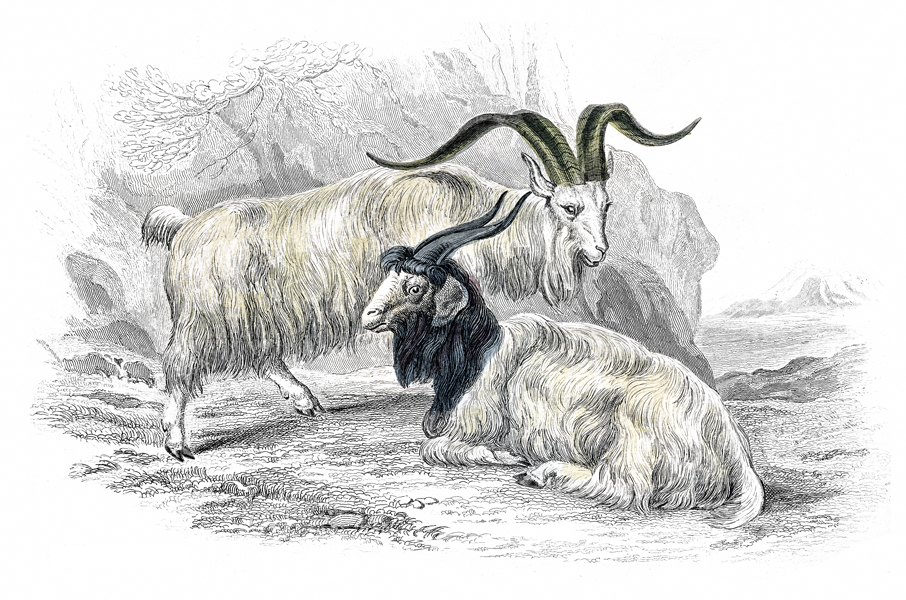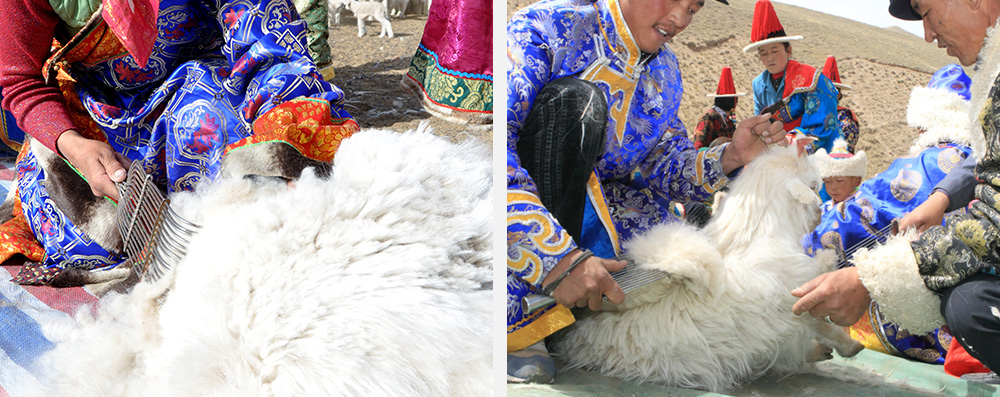

Surperior Origin
The origin of cashmere determines the quality of cashmere.
Among the producing countries of cashmere, China has the best quality of raw materials.It has a variety of terrtain in its land, that contains flat plains, vast plateaues and mountainous regions. Besides, its climates differ from each other. Therefore, it is suitable for different cultivars of goat. Then, our country has a wider range of goat distribution.The main origin contains Inner Mongolia, Xinjiang, Gansu, Hebei, Liaoning, Ningxia, Tibet, Qinghai and so on .Thereinto, a long and hard winter in those alpine regions like Inner Mongolia, Qinghai and Tibet, can give birth to the kind of cashmere goat which can withstand extreme cold. Their cashmere is thicker with longer and thinner fibers.

YILEI selects the thin and long extreme cashmere in alpine area in china as raw materials, which is thinner than 15.3μm in fiber fineness and longer than 40mm in fiber length. And it strictly check the links such as picking up, storing, organic washing and sorting to keep the quality of finished products from origins as well.
.jpg)
Picking Up Cashmere By Hand
After the goats shed lint naturally, the spring is the best time to catch cashmere as it’s warmer climate.Usually, lint shedding starts from the neck, then shoulders, chest, back, and extends throughout the goat body.Generally, cashmere catching should be carried out two times and the time interval is 3-4 weeks.Manage time can improve the output and quality of cashmere.Do it late will form “flowering cashmere”or “old cashmere”, that makes the quality of cashmere reduce.However, do it too early that cashmere has not started shedding largely, the cashmere will unable to catch up. In case of a sudden cold climate, it also causes the goats to get sick or die.
A metal comb is a tool for grasping cashmere.Before cashmere catching, people will use it to pat off sundries on the goats such as the grass, droppings and dust.When cashmere catching, the goats should be properly tied up and put down in a dry and clean place.The order of cashmere catching is from shoulder, chest, back, two ribs, then to the head and leg.Hand posture of it must be correct, and reasonable force to grasp once.The cashmere seized by heardsman from goats includes coarse hairs, two hairs, skin and sand.First, manual sorting can pick up a large mass of coarse wool,Then remove the sand impurities and some oil pollution by single burring machine or double burring machine or cone bulldozer.

Elaborately Sorting
In the process of cashmere production and purchase, there are often mixed phenomena.Colour cashmere or colour hair often appear in the purchased cashmere.Velvet is not loose enough even includes various kinds of impurities,such as sand, weed, goat droppings, artificial rope head, iron wire, chemical fiber yarn and residual cashmere.If not picked out, they will affect the quality of subsequent processes and products.Therefore, it is necessary to manually loosen and classify the original cashmere, so that
to the maximum extent eliminate all kinds of defects in cashmere and select the most velvet material close to goat skin to achieve high quality and excellent use, so then ensure product style and characteristics.
Cashmere sorting is manual operation which depends on the vision and touch of workers.It also has requirements for lighting and operation tables in the working environment.
Sorting workers require flexible action and quick response and familiar with cashmere varieties, grades, all kinds of inferior velvet and other fiber characteristics. They can sort out the original velvet according to the requirements and can distinguish the color of cashmere and other non-cashmere fibers accurately.This ability comes from the basic knowledge and long-term practice of sorting workers.

Organic Washing
During the growth of goats, there are mineral and plant impurities in cashmere, such as sand, grass, fodder residue, sweat fat, dander, urine and so on because of the feeding environment.YILEI use chemical and mechanical methods to remove grease, sweat dirt and most of the impurities on the cashmere fiber, so that cashmere presents its own color. Reducing the natural characteristics of loose, soft and elastic, so as to ensure the smooth progress of the next process such as carding and weaving.
YILEI use organic washing in this link, which is environment-friendly and also better protects the natural characteristics of cashmere fiber. The methods is green and healthy.
Organic washing process: Mechanical Loosening>Organic Washing> Drying
Organic washing is a relatively high technology work.The cashmere cleaning machine contains dirt removing equipment and five wool-washing tanks, with neutral lotion and minimum wash temperature.The temperatures of soaking tank, washing tank and water tank are different.Washing tank has a higher temperature as it needs to remove the oil and dirt of cashmere.It adopts the mode of high linquor ratio with low feed volume, that can reduce the rub between fibers and fibers or fibers and machine.Fast drying at low temperature is better. And it is good to keep the moisture regain after drying is 12%-17% and oil quantity is 1.2%-1.4%.
Cashmere will feel smooth, loose and glossy after organic washing.
Washing cashmere is mainly to wash the fat and sweat on the wool fiber, so that the impurities can be removed from the cashmere due to the loss of adhesion conditions.In the fat and sweat of cashmere, goat sweat is easy to dissolve water, so washing cashmere fat is the key link.
The basic principle of organic washing cashmere is to use organic detergent to reduce the surface tension of water and make the cashmere easily soaked. Then the organic detergent molecule penetrates into the gap of the cashmere grease dirt layer, weakens the bond between the cashmere grease dirt layer and the cashmere fiber, and destroys the cashmere grease dirt layer and divides it into many colloid-sized particles. After mechanical action, grease impurities are separated from the wool fibers.Washing is a combination of penetration, emulsification, dispersion, solubilization and foaming, and reducing the surface tension of water is the basis for increasing the subsequent spinnability.
Washing water is generally surface water and ground water, both contain a variety of suspended substances. Washing water is dissolved in water salts, such as sulfate, chloride. These salts have a great impact on washing, dyeing and finishing.So that if soap is used to wash the fibers, it is easy to form a variety of soap to adhere to the fibers, which will lead to color streaks. Therefore, the washing water must be used after softening.
